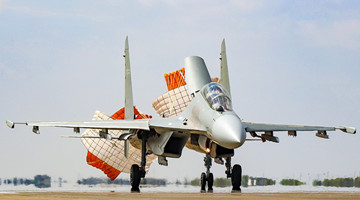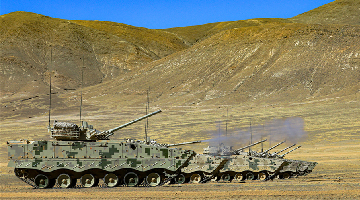
According to foreign media reports, the US military recently tested a LGM-30 Minuteman III intercontinental ballistic missile (ICBM) at Vandenberg Air Force Base in California on August 21. Before that, some media reported that the US would have an upgraded intercontinental ballistic missile capable of carrying nuclear warheads by 2029.
In recent years, the US has continued to improve its active strategic missiles, and vigorously developed next-generation strategic deterrence weapons, to maintain its hegemonic status of nuclear powers in the world. The US’ frequent quests for absolute military advantage may lead to a new round of nuclear arms race, and has aroused great concern from the international community.
Aims: Pursuing the "absolute advantage" of nuclear strategic forces
In recent years, the US has continuously increased the research and development of nuclear strategic forces, with the intention of achieving its "absolute military advantage" through technological advancement. The US believes that it is facing growing risks of nuclear threats and claims that it is unable to take effective counter-attacks due to restrictions set by various treaties. Its strategic nuclear facilities are aging, close to the end of the original design service life, so that the need of modernization is very urgent.
To this end, the US has begun to re-examine various treaties related to the development of its nuclear power, relieved itself by withdrawing from the treaties considered to be unfavorable to the US, and then carried out research and development of various new strategic nuclear forces, with a view to gaining and maintaining a new strategic edge in the competitions among major powers.
At the same time, the US has comprehensively upgraded its existing nuclear strategic strength system, including optimizing the “triad” strategic nuclear power structure and improving its nuclear weapons performance. Meanwhile, the US has continued to implement its service life extension and improvement plans, utilizing the cutting-edge technology to modernize the aging nuclear arsenal and support the construction of related infrastructure.
Means: Creating a "triad" nuclear deterrence system
At present, the US nuclear strategic forces mainly include offensive strike systems, active and passive defense systems, and backup response infrastructures capable of responding quickly to multiple threats. They are large in scale and closely combined through command, control, intelligence and planning systems. The main part is a "triad" system consisting of sea-based nuclear ballistic missile submarine (SSBN), land-based intercontinental ballistic missile (ICBM) and air-based long-range strategic bomber, each of which will support each other to form nuclear deterrent capabilities.
Sea-based strategic nuclear forces take a core position in the system with a total of 14 Ohio-class SSBNs that have been upgraded several times. At present, most of the Ohio-class submarines have been in service for more than 30 years. The US has planned to have these submarines retired by 2027 and replace them with new Colombian-class nuclear-powered subs.
In terms of air-based strategic nuclear forces, the US Air Force currently has had 20 nuclear-capable B-2 bombers and 46 nuclear-capable B-52 strategic bombers, and is constantly upgrading its nuclear command and control capabilities.
In terms of land-based strategic nuclear forces, the US has had about 400 LGM-30 Minuteman III intercontinental ballistic missiles, all of which are deployed for actual operations. The LGM-30 Minuteman III is the US third-generation ground-to-ground strategic nuclear missile and the first land-based strategic missile equipped with multiple independently targetable re-entry vehicles (MIRVs) in the US. It can carry 335,000 tons of W78 or 300,000 tons of W87 nuclear warheads, with a shooting range of 12,500 kilometers.
In addition to the "triad" strategic nuclear strike forces, the missile defense system is also an important deterrent tool for the US. At present, the US has had a comprehensive ballistic missile defense system, including ground-based mid-course missile interception system capable of intercepting intercontinental ballistic missiles, Standard Missile 3 (SM-3) interception system for intercepting medium and long-range ballistic missiles, and Patriot Advanced Capability-2 (PAC-2), Patriot Advanced Capability-3 (PAC-3) and Terminal High Altitude Area Defense (THAAD) system, all of which are anti-missile systems capable of intercepting medium- and short-range ballistic missiles at final stage. These anti-missile systems and strategic offensive weapons support each other, becoming the important means for the US military to enhance its deterrence.
Influences:Lowering the "threshold of utilizing" nuclear strategic weapons
The US’ strategic nuclear weapons are increasingly characterized by flexible deployment, outstanding actual combat capabilities and enhanced versatility. These features function to lower the threshold of utilizing nuclear strategic weapons, and consequently will also intensify the global nuclear arms race, and increase the risk of the outbreak of a nuclear war.
Since coming into power, US President Donald Trump has intended to transform strategic nuclear weapons into tactical nuclear weapons, and promote the miniaturization and intellectualization of nuclear weapons. The US Department of Defense announced in a new edition of the Nuclear Posture Review (NPR) published in February 2018 that the US should lower the threshold for the use of nuclear weapons, develop more types of nuclear weapons, and increase the flexibility of nuclear weapons in terms of shooting range and survivability. It also proposed to enrich the means of nuclear strikes, developing various types of missiles, including submarine-launched missile, low-yield nuclear warhead and submarine-launched nuclear cruise missile. At the same time, it also strengthened the ability to deploy nuclear bombers and aircraft capable of launching both nuclear and conventional missiles, to make good preparations for the actual combat of nuclear weapons in the future.
The US' vigorous efforts to develop strategic nuclear weapons will intensify the global nuclear arms race. While the US continues to reduce the "utilization threshold" of nuclear weapons, the sense of insecurity from other countries thereby increases, which will strive for the development of nuclear weapons and nuclear devices for self-protection, thus undermining the relatively stable nuclear strategic power structure that has come into being.
Subsequently, regional hotspot conflicts and the confrontation among major power get intensified, and the risk of nuclear wars increases. What is more serious is that once the strategic nuclear weapons become tactical, the difficulty in controlling nuclear weapons by the international community will increase accordingly and nuclear weapons will be much more easier to spread on a global scale, leaving many hidden dangers to international security.
(The author is a researcher with the College of International Relations under the National University of Defense Technology of the Chinese PLA)









